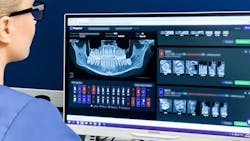AI for 3D dental imaging: It'll soon be by your side
Some people imagine an angel on their shoulder, influencing their positive decisions. Dental clinicians will soon have a voice like that. Whether you wish you had a colleague’s point of view on a radiograph or a practice development professional checking your charts for missed opportunities, Diagnocat, a new standard in the AI-powered space, can serve as those, and more.
Diagnocat creates an AI-based report from a CBCT scan that not only highlights anatomical areas, common findings, and previous treatments for each individual tooth, but also checks for 35 conditions in 2D images, bitewings/FMX, and over 65 conditions on CBCT images including rare pathology. If Diagnocat is in the room, its many benefits, from clerical to clinical, will be heard loud and clear, by you, your colleagues, and your patients.
Connecting GPs and specialists
Creating strong professional connections and constructive discussions, Diagnocat can generate reports specific to different specialties for more detailed planning and improved treatment flow.
Colleagues can use that vital information to increase success of their portion of treatment. Unlike 2D applications in the market, Diagnocat AI diagnoses the primary dentition and is the only AI service that works with 3D scans.
It can also detect periapical lesions, periodontal bone loss, signs of dental caries, open margins, overhangs, impactions, and defects of previous endodontic treatment.
Improved patient communication
Diagnocat AI’s diagnostic presentation report is ready in a few minutes; no more waiting weeks for the oral radiologist’s report. The patient-engagement section shows easily understood descriptions and explanation of concerns for each tooth. This unbiased, structured, and focused presentation can influence treatment acceptance and trust dramatically. The patient is faced with the facts of their dental issues and doesn’t have to just “take your word for it.”
You may also be interested in ... Virtual reality simulates live-patient experiences
Increased treatment opportunities
If a chart is not filled out properly or completely, information affecting possible future treatment can be overlooked. Diagnocat’s managerial report analyzes patient’s last three radiography sessions and indicates possible treatment options. Your team can inform patients of what still needs to be done or encourage them to pursue procedures that would otherwise be lost to procrastination.
For the future, a Diagnocat app is in the works that will make the process even easier and seamless. Also on the horizon is the launch of a sister company of Diagnocat—Segmentron—a treatment planning solution that will combine several forms of imaging to create a virtual patient for presentations and treatment planning for a variety of specialties.
You may also be interested in ... ChatGPT: Will it revolutionize the dental industry?
Diagnocat AI is the confident voice of diagnosis backed by facts. It helps to reduce errors, avoid missed opportunities, and give patients’ inertia a little nudge. It can streamline your protocols and improve your capabilities for diagnosis and treatment planning. You don’t need that whispering angel on your shoulder, if you actually have Diagnocat AI technology by your side.
Editor's note: This article appeared in the November 2023 print edition of Dental Economics magazine. Dentists in North America are eligible for a complimentary print subscription. Sign up here.
Lou Shuman, DMD, CAGS, is the CEO of Cellerant Consulting Group, dentistry’s leading corporate incubator and accelerator. He is a venturer-in-residence at Harvard’s i-Lab, cofounder of LightForce Orthodontics, a member of the Dental Economics advisory board, and founder of the Cellerant Best of Class Technology Awards. He was selected in 2021 by Global Summits Institute as one of the World’s Top 100 Doctors. Dr. Shuman is a consultant for many leading companies in the dental industry, including Diagnocat.
About the Author

Lou Shuman, DMD, CAGS
Lou Shuman, DMD, CAGS, is the CEO of Cellerant Consulting Group, dentistry’s leading corporate incubator and accelerator. He is a venturer-in-residence at Harvard’s i-Lab, cofounder of LightForce Orthodontics, a member of the Dental Economics advisory board, and founder of the Cellerant Best of Class Technology Awards. He was selected in 2021 by Global Summits Institute as one of the World’s Top 100 Doctors.
Updated September 20, 2022
